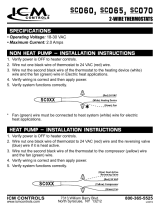
9
for connecting the supply wires to the unit. Use of rain
tight conduit is recommended.
• See the unit wiring label for proper high and low voltage
wiring. Make all electrical connections in accordance
with all applicable codes and ordinances.
CAUTION:
Label all wires prior to disconnection when
servicing controls. Wiring errors can cause
improper and dangerous operation. Verify proper
operation after servicing.
• Units are shipped from the factory wired for 240 volt
transformer operation. For 208V operation, remove the
lead from the transformer terminal marked 240V and
connect it to the terminal marked 208V.
Table 4 (page 10) lists the basic airfl ow values versus the
airfl ow selector switch settings and the range of basic
air fl ow settings recommended for each nominal system
capacity.
NOTES:
• The CFM values listed in the tables are not dependent
on duct static pressure. The motor automatically
compensates for changes in duct static pressure (within
the limits of the motor).
• For maximum capacity and energy effi ciency, select an
airfl ow at or near the top of the range for that nominal
capacity.
• For maximum dehumidifi cation, select an airfl ow near
the middle or bottom of the range for that nominal
capacity. Additional information on humidifi cation and
dehumidifi cation can be found on page 13.
• If coil icing is observed, the basic cooling/heat-pump
airfl ow selected may be too low. Check the setting and
make sure it is within the range shown in Table 4. Also
verify the system is properly charged. See charging
charts on pages 20 - 21. If icing continues to occur,
raise the selected airfl ow one or two steps.
Selecting the Minimum Electric Heat Airfl ow
The minimum electric heat airfl ow is selected by setting
switches 5 and 6. Selecting the minimum electric heat
airfl ow sets the minimum air fl ow that will be produced
whenever electric heater kits are used. When the electric
heater kits are energized along with a heat pump, the
airfl ow may be higher depending on the basic cooling/
heat-pump airfl ow setting.
See Table 2 (page 10) for recommended minimum electric
heat airfl ow settings. The minimum electric heat airfl ow
setting may be set higher, but must never be set lower
than the setting shown in the table.
Selecting the Delay Profi le
Delay profi le selection controls the start-up and shut-down
characteristics of the packaged heat pump unit. By varying
the start-up and shut-down characteristics, the system can
be optimized for energy effi ciency, humidity control, and
comfort. The delay profi le is selected by setting switches
7 & 8 (See Table 3 page 10).
Select Delay A or Delay B
for highest energy effi ciency:
• Delay A has a two-step ON delay. The blower will
begin operation at 31% airfl ow for 30 seconds. The
second step operation is 75% airfl ow for 30 seconds.
After the two-step ON delay has been completed, the
blower operation will run at 100% until the thermostat
has been satisfi ed. Delay A also provides a 60 second
OFF delay at 50% airfl ow.
• Delay B has a single step 30 second ON delay at 50%
airfl ow and also provides a 90 second OFF delay at
50% airfl ow. Select the delay profi le which is most
suited to the application. See Table 3.
• The DeHum delay profi le may be used when humidity
control is needed without the use of an optional
Grounding
WARNING:
The unit cabinet must have an uninterrupted or
unbroken electrical ground to minimize personal
injury if an electrical fault should occur. Do not
use gas piping as an electrical ground
!
This unit must be electrically grounded in accordance
with local codes or, in the absence of local codes, with
the National Electrical Code (ANSI/NFPA 70) or the CSA
C22.1 Electrical Code. Use the grounding lug provided in
the control box for grounding the unit.
Selecting Proper Airfl ow for Variable Speed Units
Th Q4SE packaged heat pump is equipped with a
microprocessor-controlled variable speed motor that is
pre-programmed to deliver optimum airfl ow in a variety of
conditions and system confi gurations. The unit responds
directly to the thermostat inputs, as well as the optional
humidistat (If installed). During normal operation, the motor
will gradually change speeds during start-up, shut down,
when thermostat inputs change, and when the duct static
pressure changes (vents closed or opened, fi lter clogging,
etc.). The heat pump unit is also confi gured by setting
the selector switches and removing jumper connectors
as directed below.
NOTE: This packaged heat pump has been designed to
give the installer maximum fl exibility to optimize system
performance, effi ciency, and comfort. With so many
different ways to set up the packaged heat pump, it is
important to read and follow all directions carefully.
Selecting the Basic Cooling/Heat Pump Airfl ow
The basic cooling/heat-pump airfl ow is selected by setting
switches 1 - 4 on the thermostat input board located on the
blower. All airfl ows for other modes of operation (except
electric heat) are determined by this basic setting.




















